Jordan #4: City of Amman

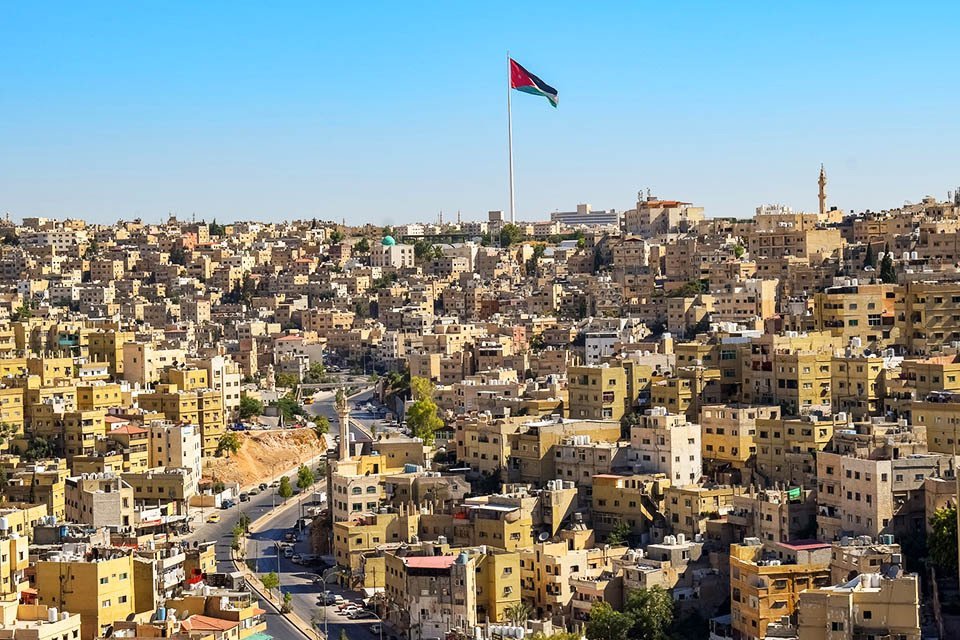
Amman, being the capital of Jordan since 1921, is a relatively young city, a creation of the 20th century. In little more than 100 years, the insignificant village turned into a huge agglomeration.
Why was it here that Emir Abdullah, then the ruler of Jordan, decided to create the capital of his country? One of the main reasons was that the place was on the route of the great Ottoman railway line (it is now closed), which connected Saudi Medina with Syrian Damascus. Thanks to pilgrims traveling on this route and stopping in Amman, the city started to develop.
If you want to know more, start reading the paragraph about the history of the city of Amman, just below.
History of Amman
Somehow it happens, that every time I start new blog entry, I'm first searching for information about the history of the place being described and presenting it to you. Personally, I love history, but I understand, if not everyone shares my point of view, so if old stories are not for you, go below - you'll find lots of information about the most interesting places and tourist attractions of Amman. And if you're still here, let's get together into the history of this Jordanian city.
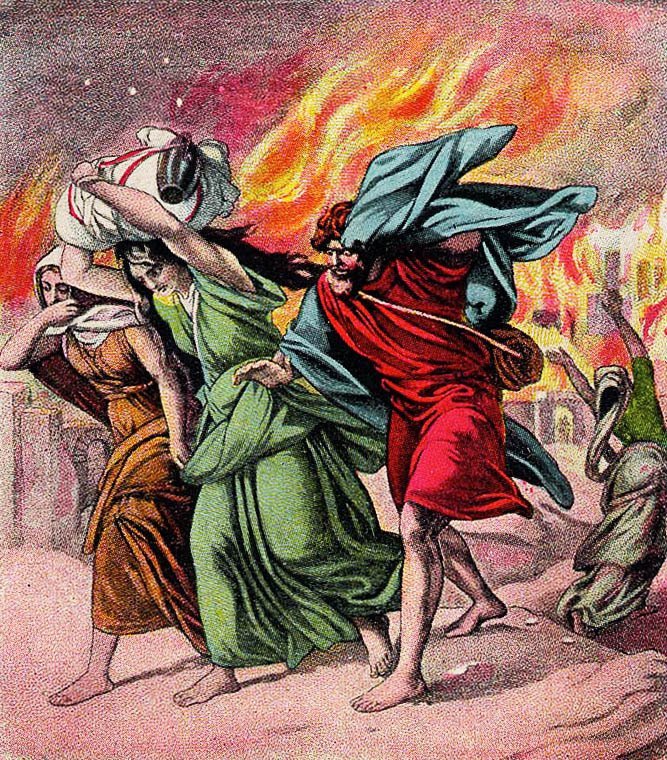
Antiquity
It is worth starting with the fact that Amman is an ancient settlement, which was already described on the pages of the Old Testament, when it was called Rabbat Ammon (Rabba for short). Already in the 12th century BC Ammonites (an ancient Aramaic tribe) settled here, who according to the Bible were descendants of Lot who fled from Sodom.
During the time of David, the king of Israel, the city was unsuccessfully besieged by his general Joab, and after that it was conquered in the third century BC by Ptolemy II Philadelphus, king of Egypt, who changed city name to Philadelphia. Precisely as Philadelphia, the city was known for many hundreds of years during the Roman Empire.
Middle Ages
The name changed again to Amman only when the Nabataeans (Petra builders) settled in this area, expanding and bringing the city to its splendor. The Nabataeans people lived here until 635, when the settlement was taken by the Arabs. Its slow decline began a century later, just after the caliphate capital was moved from the city of Damascus to Baghdad.
Amman slowly lost its importance, and when the Turks took it in the 16th century, it was completely abandoned.

Modern times
Stagnation of the city lasted until the second half of the 19th century, when in 1878 it was rebuilt by Circassian settlers (Circassian - an ethnic group from the northwest of the Caucasus). Not much later, in 1903, a train station was opened in Amman on the line from Medina to Damascus, which contributed to the dynamic development of the city, attracting numerous merchants. After Amman's significance surpassed the old capital of the province called As-Salt, in 1921 the city became the new capital of the Emirate of Transjordan, and twenty-five years later the capital of an independent country Jordan, with about 35,000 inhabitants.
When the First Israeli-Arab War (1948 - 1949) ended, thousands of refugees from Palestine began to move into Jordan. During this time, the population of Jordan increased from 400,000 to more than 1.1 million, of which 2/3 were former Palestinians. Already in 1952, nearly 200,000 inhabitants lived in Amman, of which almost half in two refugee camps. The country began to grow rapidly: the Arab Bank moved to Amman, which concentrated most of Jordan's economy, also the first university was built.
At the end of 1955, the authorities of Amman decided to join Jordan to the Baghdak Pact, which caused numerous protests by the Palestinian people. Fourteen years later, the Palestinian Liberation Organization, with the support of people living in refugee camps, begin to fight the Jordanian army in an attempt to gain control over the city. The Jordanian authorities lost control so much that in 1970 even the car of King Hussein was fired, which started the civil war called Black September. It resulted in the withdrawal of Palestinian formations from Jordan.
Well, enough history, it's time to see what we can see in Amman. What are the most interesting places and tourist attractions in the city today? Let's find out!
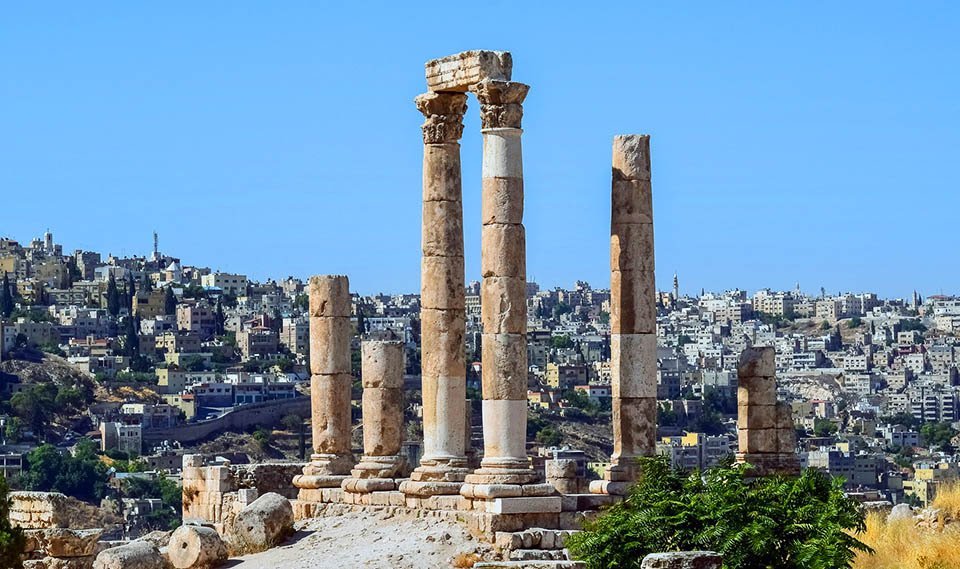
Amman Citadel (Jabal al-Qal’a)
The fact that the city of Amman was created almost fully in the last 100 years does not mean that it is devoid of historical monuments. One of them is the Citadel in Amman, in Arabic called Jabal al-Qal - a building whose history dates back to 1800 BC.
Amman, like Rome, was built on seven hills, and the citadel is located on the highest of them, 850 meters above sea level. It is worth climbing here, even for spectacular views of the city, but also to see the remains of the Temple of Hercules, the Palace of the Umayyads or the Byzantine Basilica.
Museum near the citadel
In the Citadel in Amman we find the Jordan Archaeological Museum, in which we can see various excavated finds, not only from the citadel or city, but also from Jericho or Petra. These are mainly everyday items, but also the so-called "Scrolls of Qumran", which are fragments of scripture that were found in the caves at the city of Qumran on the Dead Sea.
In various halls of the museum you will also find clay sarcophagus with closures like human faces, dated 10th - 5th century BC, a statue of Atargatis, which was the Nabatean goddess of leaves and fruit, or a beautiful Nabatean temple bowl, dated to the 2nd century BC. It is also worth paying attention to the frescoes from Chalcolithic (dated 4,000 BC) and the old plaster statues from Ain Ghazal, which are even older (Neolithic).

Roman Theater
The Roman Theater (remains of Roman Philadelphia) is definitely one of the most interesting tourist attractions in Amman. It lies at the foot of the Citadel, so you should not have a problem spotting it.
The construction dates from the second century AD, and in its times of glory the Roman Theater could accommodate as many as 6,000 people. Currently, it is one of the most popular places for spending time by both tourists and locals.
In front of the theater there is a large square, perfect not only for a walk or evening relaxation, but also for playing football (you can try to play with the locals). In addition, near the entrance to the theater, we can find the Museum of Folk Traditions and the Folklore Museum. When we have sufficiently enjoyed the historic places of Amman, we set off on a further journey through the Hashemite Kingdom of Jordan.
Downtown
Leaving the history behind, we get to Downtown of Amman, perfect for evening walks. In my opinion, this is by far the most colorful, lively and diverse part of the city, where we have the opportunity to discover new flavors at every step, from ordinary street food, through fruit juices or sweet knafas, to various pubs.

It was food that focused my journey through the Amman's Downtown, because after visiting the Roman Theater and the Citadel I became terribly hungry. My favorite place to eat something quickly was Falafel Hashem, which was filled with teenagers and families, and hummus, falafels and mint tea soothed my hunger and fatigue easily. The prices were also very reasonable.
After eating, it is worth visiting one of the numerous patisseries in the side streets for the dish called Knafeh, which is a sweet cheese cake. Fantastic!
Road from Downtown to Paris Square
With full stomach I left downtown and headed towards Paris Square, passing many charming streets along the way. This is another area where you can see tourists mixing with local young Amman residents. It is less historic here, but definitely more modern.
It is definitely worth paying attention to the huge stairs that connect the lower center with the upper part of the city. The whole road is filled with hidden on the sides Jordanian pubs (where you can go for coffee with cardamom) and street art: from painting portraits to bands playing traditional Jordanian music.
King Abdullah I Mosque
Going further west and making a quite pleasant 1.5 km walk, we reach a wonderful, large building called King Abdullah Mosque. The temple itself can be easily visited inside, all you need to do is remember to wear appropriate clothing as you enter the Islamic prayer building.
Interestingly, right next to King Abdullah Mosque in Amman there is a large Christian church, and both temples even have a shared parking lot. It is also amazing (which I associate with the city of Mostar in Bosnia and Herzegovina) that Christians and Muslims greet and talk to each other without any problem. Well, I'm happy about that, because too many people are looking for divisions where agreement and similarity should be sought.
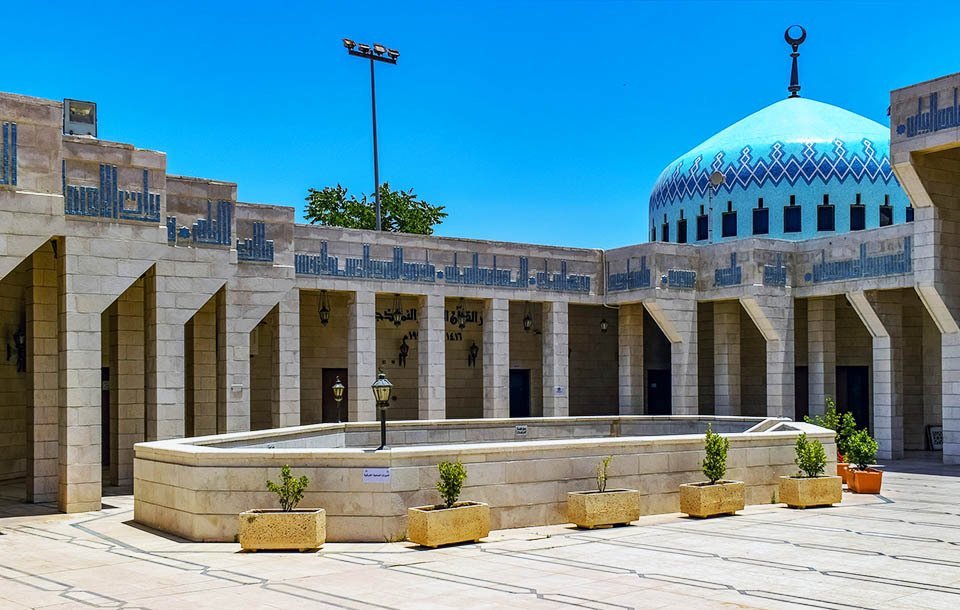
I didn't have such a need, but if you come to the conclusion that here and now you really need to do shopping, and not just any, because in big Jordanian shopping centres, after literally a few minutes walk towards the center from King Abdullah Mosque you will reach the business part of city with numerous office buildings and shopping malls.

Jabal Amman
Jabal means "hill" in Arabic, so it's not surprising that the Jabal Amman area abounds in numerous up and down paths, which will give our muscles a good impression. The plus is that wherever we go, we can often find a new, unique, great view. It is worth adding that the hill on which Jabal Amman lies was one of the first on which the peoples settled in this area (during the Stone Age).
Nowadays, Jabal Amman is part of downtown Amman, but the more interesting one. We will find numerous historic buildings here, and in addition, if we're on Friday (only in summer), we can look at the Souk Jara flea market, filled with various and often strange items for sale.
Rainbow Street
Rainbow Street in Amman is the main and most colorful street in downtown Jebel Amman. It is a colorful, bustling place filled not only with restaurants and cafes, but also with numerous smaller shops (not only with souvenirs) or art galleries.

King Hussein Mosque
The King Hussein Mosque is the largest mosque in Amman, unfortunately away from the city center by a good 13 kilometers, which, however, by Uber is not so expensive (I advise against public transport). It was built in 2005 during the reign of King Abdullah II. In addition, the king also opened here the Museum of the Prophet Muhammad in 2012.
King Hussein's Park
Around the Hussein Mosque is the large Al Hussein Park, where you can relax from the scorching sun. The mosque itself and King Hussein Park are located on a large hill (over 1 kilometer high), making them visible from many parts of the city.
PS. If you don't want to move so far away from the city center, you still have the Grand Al-Husseini Mosque, which has similar name and the above is often confused with :-)
Pigeon Market
Pigeon Market is one of the most interesting tourist attractions in Amman. The place can be found near Al-Hashemi street, right next to the partially preserved Roman fountain called Nymphaeum (it is also worth seeing by the way).
Being close to the Pigeon Market, I froze for a moment when I saw paper bags with pigeons inside. There were hundreds of them! For a moment I thought that maybe they were eating them, luckily I was quickly explained how it really is.
I learned that one of the national sports in Amman, existing here since 1150, are flights of trained pigeons, and the more you have them and the more you train, the more respected you are and the more likely you are to win. What do such trained pigeons from Pigeon Market do? Well, they are either trained to fly from one place to another (once they probably had letters), or to come on a whistle or on a muezzin call to Islamic prayer from a minaret.
Jabal al-Weibdeh
The Middle East is known for the rich history of various artists, writers, musicians and poets. After decades of fighting, wars and occupation, a generation has arisen that is trying to create a modest (so far) cultural district, which is Jabal al-Weibdeh.
The Jabal al-Weibdeh district is located between two culturally differed areas of Amman:Jabal Amman (the one with historical buildings and monuments) with the urbanized downtown "Al Balad", and the so-called East Amman, a poor part of the capital. Jabal al-Weibdeh in Amman, being between them, partly absorbed their mix, where urbanization and slums mix at every turn.

Royal Automobile Museum
If you are passionate about old cars and motorbikes, then the Royal Automobile Museum in Amman, showing the collection of the dead King Hussein, is definitely the place for you.
The Royal Automotive Museum was established to honor the King of Jordan who ruled these lands from 1956 to 1999. The ruler was a huge fan of vehicles, both cars and motorcycles, so his son, the new King of Jordan Abdullah II, decided to honor his father's memory by building a museum.
We find here various cars and motorbikes that are over 50 years old, as well as modern cars such as royal Rolls-Royce. This combination of classics and history with old cars in the background will provide a lot of entertainment, so it's worth going here.
Safety
Traveling in Jordan is simple and relatively safe, even for lonely travelers. Since Jordan is not a large country, it is easy to navigate here, especially since the infrastructure is at a decent level.
Before coming here, it is definitely worth reading the instructions on proper clothing and behavior so as not to discourage residents who are still Muslims. Sometimes the people in Jordan may seem a bit offensive, especially if they will figure out that we are tourists - it's bcause in these kind of countries everyone wants to earn, so they often try to talk to us as long as possible, offering their goods. Some people like it, others don't - a matter of taste.
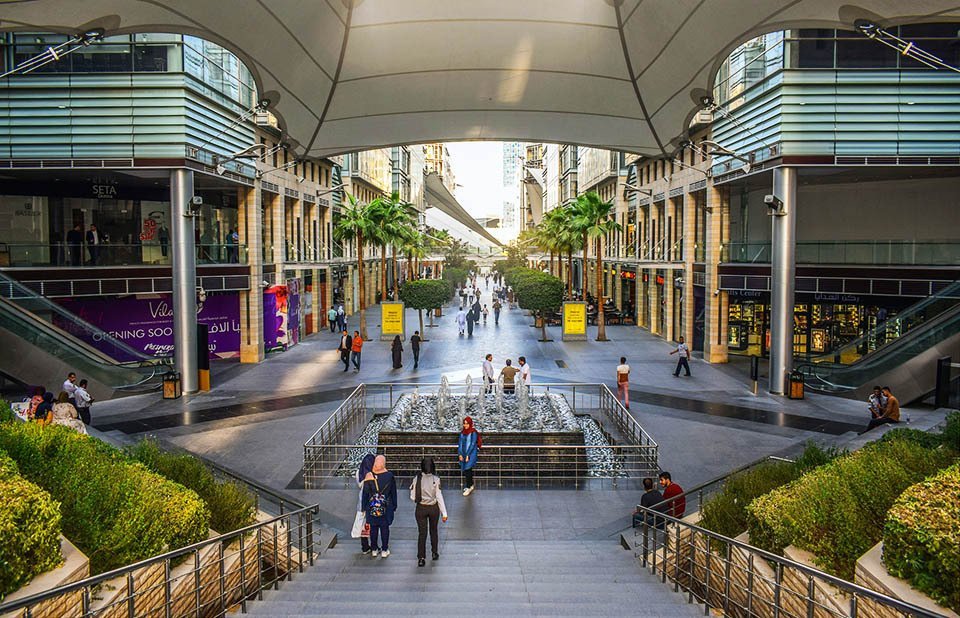
Transport
You can get around Amman and Jordan in several different ways, including car, taxi, Uber, public transport or (sometimes) hotel transport. Below I will try to describe them all.
Car
If we feel good about driving a car in foreign cities, and above all if we plan to visit tourist attractions and interesting places in Jordan outside of Amman, this is the best way of transport. However, you have to get used to less lights or other "road facilities" than in Europe or the United States, Jordanians are also not among the best drivers who stick to the road rules.
I recommend that you get an insurance just in case and avoid getting around Amman during rush hours, unless we are very experienced drivers. In general, the main roads are in very good condition, so unless we get into some wild areas, we should not have problems with it.
As a curiosity, I will add that on the highways in Jordan, once in a while we come across a concrete speed bump, so it's worth observing the signs that warn us about them.
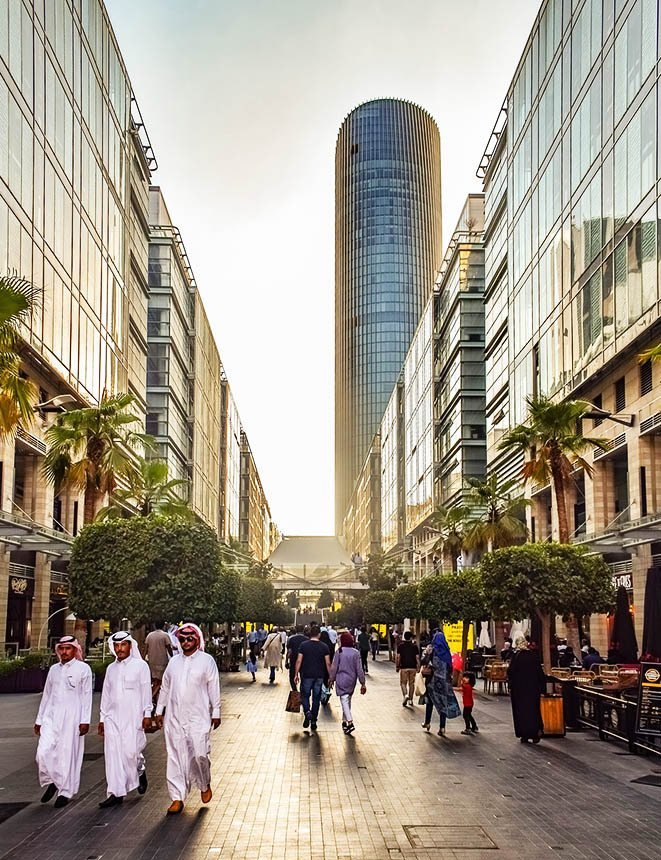
Taxi and Uber
As for Uber, it works in Amman and you can definitely use it. Drivers do not always speak English, but actually we do not need it very much to get where we want.
As for taxis, we will find two types here: private taxis and so-called service taxis - the first ones can take us wherever we want (even outside the city) and usually use the odometer (which does not mean that we can not try to arrange a specific amount of manyfor the drive), while the second only go from a specific place to another specific place and their fee is always fixed.
Of course, it is much more profitable to drive Uber, as taxi drivers often try to earn as much as possible on an unaware tourists.
Public transport
To be honest, I didn't travel around Amman even once by public transport. Both reviews read on the internet and heard stories from local people effectively discouraged me from it.
Most likely it works so that a given bus can arrive an hour later, half an hour earlier, or not at all. If you are in Amman yourself and try to move public transport, let me know how it was, I will update this section.
Hotel transport
Many hotels in Amman (as well as throughout Jordan) offer us not only various trips, but also transport from the hotel to the most interesting places and tourist attractions. It is worth to ask about it, because it will not only make our sightseeing more comfortable, but also make it faster.

Practical information
Below you will find some practical information on Amman and Jordan, in a nutshell.
Currency
The currency in Amman is Jordanian Dinar (JOD for short). Currently, one dinar is about 1.41 USD.
Language
Of course, the most spoken and most common language is Arabic, although many people in Amman and Jordan know the basics of English well enough to get along with us.
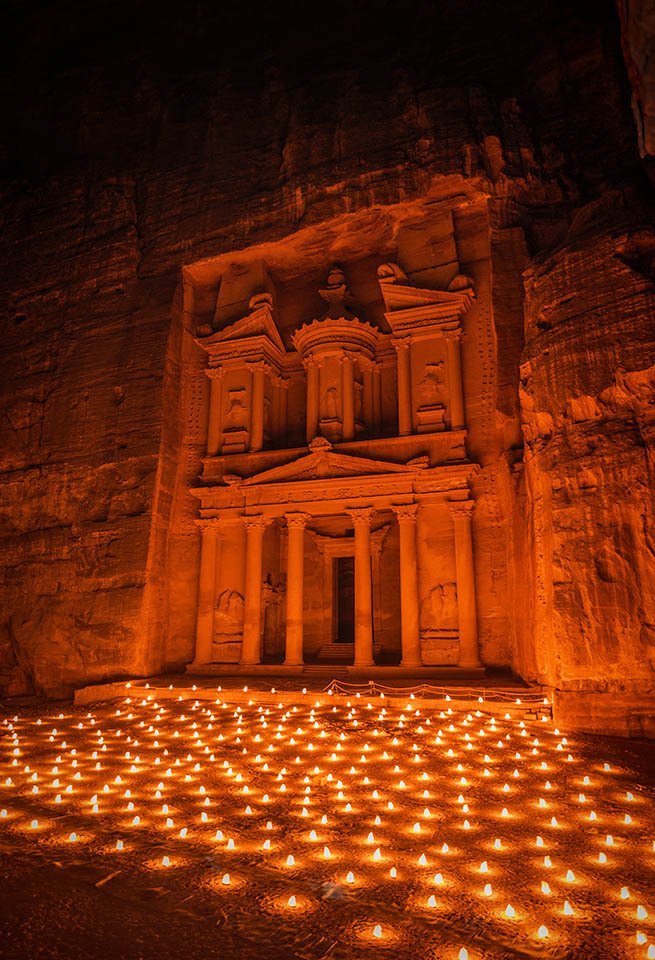
ATMs and credit card payments
ATMs can be found in many places in the city of Amman, with most major restaurants or hotels accepting credit cards (mainly Mastercard and Visa).
Weather
In Amman it is warm all year round (even in winter), so the best time to travel to Jordan is in March - May or September - October, when the temperatures are like "holiday", but they do not knock us off our feet. Personally, I was in Amman and Jordan in July and I also survived, so if you really want to, I don't see any contraindications for travel, even in July or August. Although it was quite hot.
Summary
Amman in Jordan is a beautiful city with both a unique atmosphere and lots of interesting places, tourist attractions and historical monuments. Arriving here is worth spending a few days in the city, and then set off on a further journey around Jordan and visit Petra, the Wadi Rum desert and Mount Nebo.
Regardless of whether we treat Amman as a starting point for the rest of the country or as a destination itself, Jordan will undoubtedly delight us and allow us to discover the exotic of the Middle East.

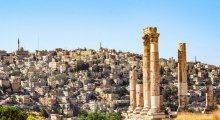



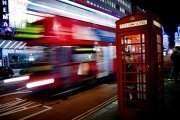
The Jordan Valley area and Aqaba (the Red Sea coast) are warm during winter months of December, January, and February, but extremely hot during summer. Places like Dana and Petra receive snowfall in winter . According to Jordanian culture: Jordan has a relatively liberal society and tourists can wear western clothes in modern cities like Amman and areas like Dead Sea but there are a few things visitors must keep in mind while walking in more conservative areas. Women should wear loose-fitting clothes covering their legs, arms and chest, while men should wear long loose-fitting trousers, T-shirts or high collar shirts.